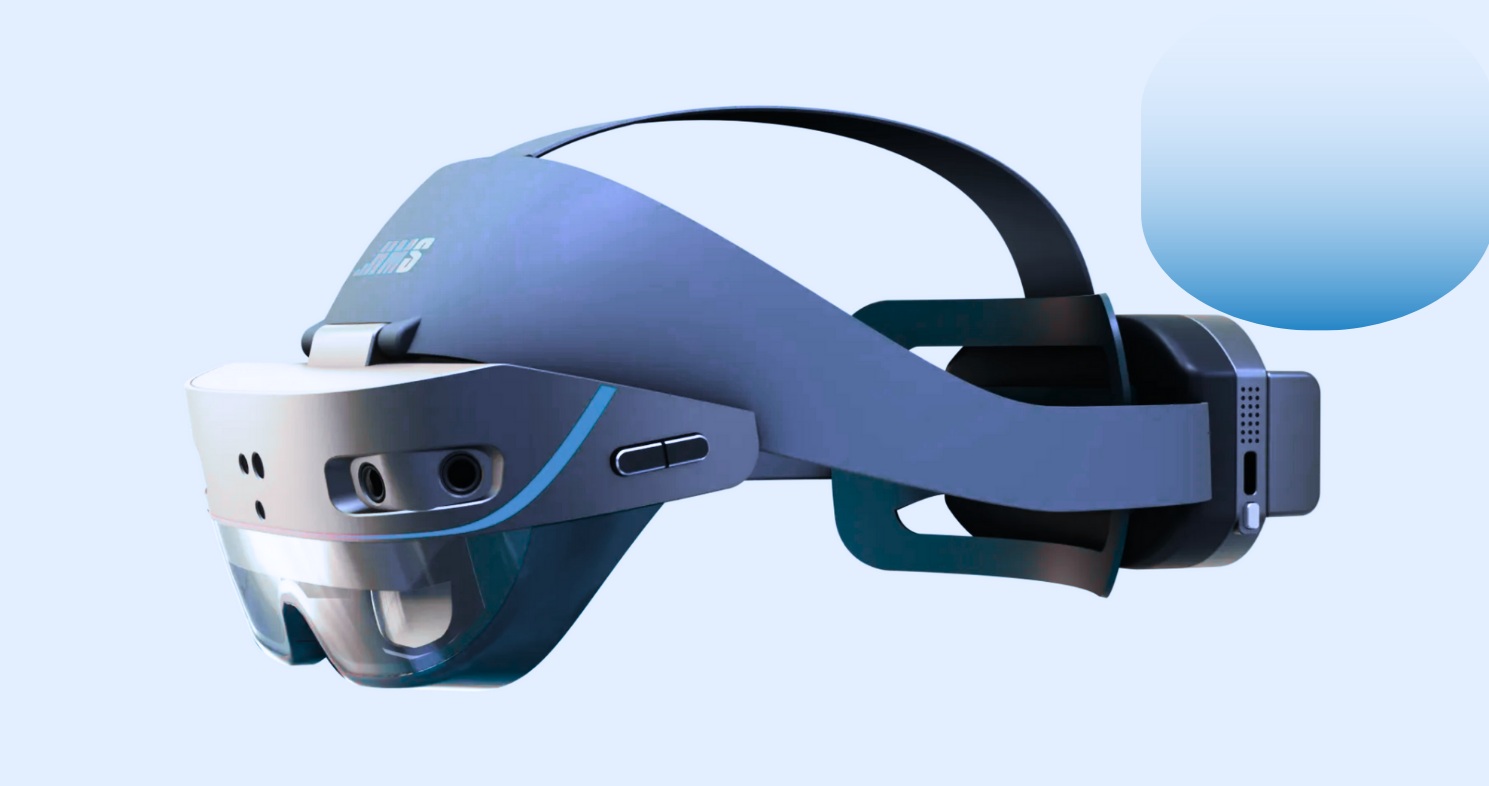The HMS SiNGRAY G2 AR headset will stand as a direct competitor to Microsoft’s HoloLens 2, and it’s got XReal-style Birdbath optics. This headwear is positioned as an enterprise-focused AR headset with high-resolution micro-OLED displays and a powerful onboard chipset. Interestingly, this device will run as a standalone headset, running its own OS, powered by Qualcomm’s Snapdragon 8 Gen 2 (QCS8550) and a dedicated Intel Movidius Myriad X vision co-processor.

To further note, the SiNGRAY G2 offers 1920×1080 stereo visuals at 90Hz refresh rate with a 47–51° diagonal field of view, while also meeting rugged enterprise requirements like IP65 dust/water protection and a hot-swappable 4,800mAh battery.
Here, we will explore the features, specs, and offerings of the SiNGRAY G2, which really is an AR headset built for demanding industrial use.
Meet the HMS SiNGRAY G2 AR Headset
The design isn’t too different from what we’ve seen from AR headsets, especially the HoloLens 2. However, the SiNGRAY G2 comes lighter in weight and is pretty much more aesthetically pleasing. However, the main talking point is the Birdbath Optics.
Birdbath Optics and Field of View
Honestly, Birdbath optics isn’t the best you can get on an AR device, especially when you’re talking wider field of view and display quality. Birdbath uses a small concave mirror to magnify a microdisplay into the user’s view, and in the SiNGRAY G2, it is paired with a Sony 1920×1200-pixel micro-OLED display for a sharp, full-color overlay on each eye.
Unlike the Xreal that relies on your phone for processing, the G2 houses its computing on board, allowing it to serve full AR use-cases. The tradeoff is that birdbath optics make the real world appear somewhat dimmer, allowing for the capture of bright virtual overlays. What this means is that, in practice, the G2’s transparent lens can become moderately opaque, and this is quite acceptable for some users, but less ideal for anyone seeking a crystal-clear view of the real scene.
Display and Performance
Each eye of the SiNGRAY G2 puts out 1920×1080 pixels from a Sony-made micro-OLED panel, refreshing at 90Hz. This high-resolution display exceeds HoloLens 2’s 1440×936 panel and stands on par with many VR headsets. HMS calls it “one of the highest HD resolutions in the AR headset space.”
The combined field of view spans roughly 51° diagonally (about 45° horizontal by 28° vertical), which gives a comfortable viewing area for enterprise UIs and 3D models. Inside, the G2 is powered by Qualcomm’s Snapdragon 8 Gen 2 class chipset (the QCS8550 variant). This is the latest 4nm mobile SoC used in devices like Meta’s Quest 3 and Pico 4 Ultra (as the XR2 Gen2). It delivers roughly 3–4× the processing power of the Snapdragon 850 inside HoloLens 2.
To manage sensor data, tracking, and gesture recognition, HMS also includes an additional VPU—Intel Movidius Myriad X vision (VPU). This dedicated AI coprocessor handles computer vision tasks at low power, mirroring Microsoft’s approach of offloading SLAM/tracking to a separate chip. The combination means the G2 can render complex 3D graphics while simultaneously doing high-frequency tracking.
In benchmark terms, the G2’s hardware promises far more horsepower than older AR headsets, and could possibly outperform the Quest 3 (which offloads tracking to its main chipset), thanks to the dedicated VPU.
Tracking and Sensors
The G2 is built for precise spatial tracking. It carries dual fisheye cameras for visual SLAM, a time-of-flight (ToF) depth sensor, and a 13‑megapixel RGB camera. These work together with a 9-axis IMU to localize the headset at up to 1000Hz SLAM update rate. In effect, the user’s head is tracked in real time with six degrees of freedom when needed.
This sensor suite is comparable to other enterprise AR devices: for instance, Microsoft HoloLens 2 uses stereo cameras plus depth and inertial sensors, while Magic Leap 2 added a similar array. The SiNGRAY G2’s difference is its standalone approach. All the sensor data is fused on-device (using the Movidius VPU) into a spatial map. This means it can support remote collaboration (streaming a 6DoF video feed) or on-board applications like markerless CAD registration.
Notably, the G2 does not include eye-tracking – a feature present on HoloLens 2. This simplifies the design and saves power. Without eye cameras, all user input must come from gestures, controllers, or external devices. For some industrial AR use-cases, this is a reasonable tradeoff.
Battery, Build, and Ergonomics
The SiNGRAY G2 is built for enterprise use, so the chosen material is rugged and fortified – IP65 rating – to offer water and dust resistance. The headband and casing use a mix of aluminum and reinforced plastic materials, and the headset itself features an adjustable electrochromic front lens so wearers can manually darken or lighten the see-through view for different lighting conditions.
Power-wise, the headset runs on a 4,800mAh battery, and this battery is hot-swappable; plus, there’s an internal buffer that keeps the device alive for about three minutes during a swap. The battery doesn’t really add that much of a weight, so you can carry everything (including a spare, if you got one) along with your daily gear.
Software and Ecosystem
On the software side, the SiNGRAY G2 runs a custom Android-based OS and supports industry-standard AR frameworks. It is OpenXR-compatible and works with Unity’s AR Foundation, making it easier to port applications. HMS partnered with frontline.io, so every G2 unit ships with frontline.io’s suite pre-installed.
The G2 software integrates digital twin visualization, remote assistance, interactive 3D workflows, and annotation tools. From the ground up, it appears the G2 targets real-world productivity, and not just flashy demos. It supports voice control (via on-board mic) and hand gestures as input, leveraging standard APIs. It also has WiFi 5 and Bluetooth 5.2 for connectivity.
| Feature | HMS SiNGRAY G2 | Microsoft HoloLens 2 |
|---|---|---|
| Processor | Qualcomm Snapdragon 8 Gen 2 (QCS8550) + Intel Movidius Myriad X VPU | Qualcomm Snapdragon 850 + HPU 2.0 |
| Display | 1920×1080 micro-OLED per eye, 90Hz | 1440×936 waveguide per eye, 60Hz |
| Field of View | 47–51° diagonal | 52° diagonal |
| Optics | Birdbath (XReal-style) | Waveguide |
| Tracking | 6DoF visual SLAM, ToF depth, 1000Hz updates (no eye-tracking) | 6DoF with eye-tracking |
| Battery | 4,800mAh, hot-swappable (3-min buffer) | ~2–3 hours, non-swappable |
| Build Rating | IP65 dust/water resistance | IP50 (Industrial Edition: enhanced) |
| Weight | Lighter and more refined (exact TBD) | 566g |
| OS/Software | Custom Android-based, OpenXR, frontline.io pre-installed | Windows Holographic, OpenXR |
| Price (Est.) | TBD (likely ~$3,500 range) | ~$3,500 |
| Availability | Pre-orders late 2025, shipping 2026 | Discontinued (out of stock) |
Conclusion
At the moment, there is no public price announced for the SiNGRAY G2 headset; pre-orders are, however, expected to open this year, while mass production and shipping start in 2026. HMS will really melt hearts if they deliver exactly what they promised on the G2 AR headset.
